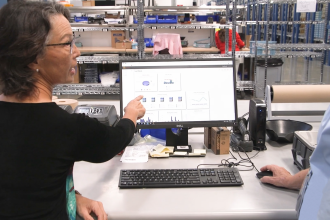Digitization of Intralogistics: Labor

Managing information rather than products is a good way to attract and retain labor—key in today’s environment.
One of the most critical topics in today’s warehousing and manufacturing is digitization of intralogistics. It represents the flow of both materials and information and aims to add efficiencies by improving a variety of factors, including accuracy, flexibility, throughput, speed, safety, and cost. In short, digitization enables the tracking of material and information flow and its optimization.
To digitize, companies need several components of automation and technology. Easy starting points include barcode scanning at picking stations, for instance. It is often used with a software system such as a warehouse management system (WMS) or a warehouse execution system (WES). These provide improved granularity and real-time visibility in the facility. You will likely need to add additional layers of automation to complete the picture and optimize the digitization.
Labor is one key place where you can apply digitization. Right now, the labor shortage accounts for over 50 percent of the costs in many warehouses. These include both direct and indirect costs, such as benefits, training, and hiring costs. Attracting new labor to industrial settings for manual labor is becoming increasingly more difficult and so is retention. Turnover in the 30 percent range is not uncommon, making retention key to hitting your productivity goals. This is where digitization can be helpful.
By using advanced tools for measurement, companies can better understand what it typically takes staff to accomplish various tasks. This, in turn, allows managers to better establish standards to assist with planning. For instance, if you notice that the typical worker can pick 100 items in 100 minutes, and one employee drops that number down by five minutes, you have the opportunity to explore their method. Are they doing something different than others? Identify this as a best practice and roll that out to others.
You can also then use these standards to set up incentives for employees. In that same example, you can reward the employee who accomplishes more in less time. This can be helpful in employee retention.
Finally, the younger, up-and-coming workforce has been raised in the digital era. By rolling out tech and tools on the warehousing floor, you’re more likely to attract and retain them. Cutting edge, modern facilities that incorporate mobile robots or more interfacing technologies with the WMS via screens and handheld devices are all attractive to this generation. Manual labor, on the other hand, is often less desirable to this demographic. Think project oriented jobs versus task oriented jobs.
Such a scenario has the added bonus of a safer work environment, as technology replaces some of the repetitive manual tasks and labor intensive work in a warehouse. That makes your facility one where it’s easy to connect to information, make decisions with that information, be more productive, and attract and retain high-quality, productive warehouse associates.
For more information about the Solutions Community: mhi.org/solutions-community
For further articles from the Solutions Community:
Digital Twin for Intralogistics
The Digitization of Intralogistics: Returns
Past vs. Future: The Difference Between On-Premise and Cloud-Based WMS
Sophisticated Condition Monitoring
Reduce Your Energy Consumption
The Digitization Of Intralogistics: Sortation



